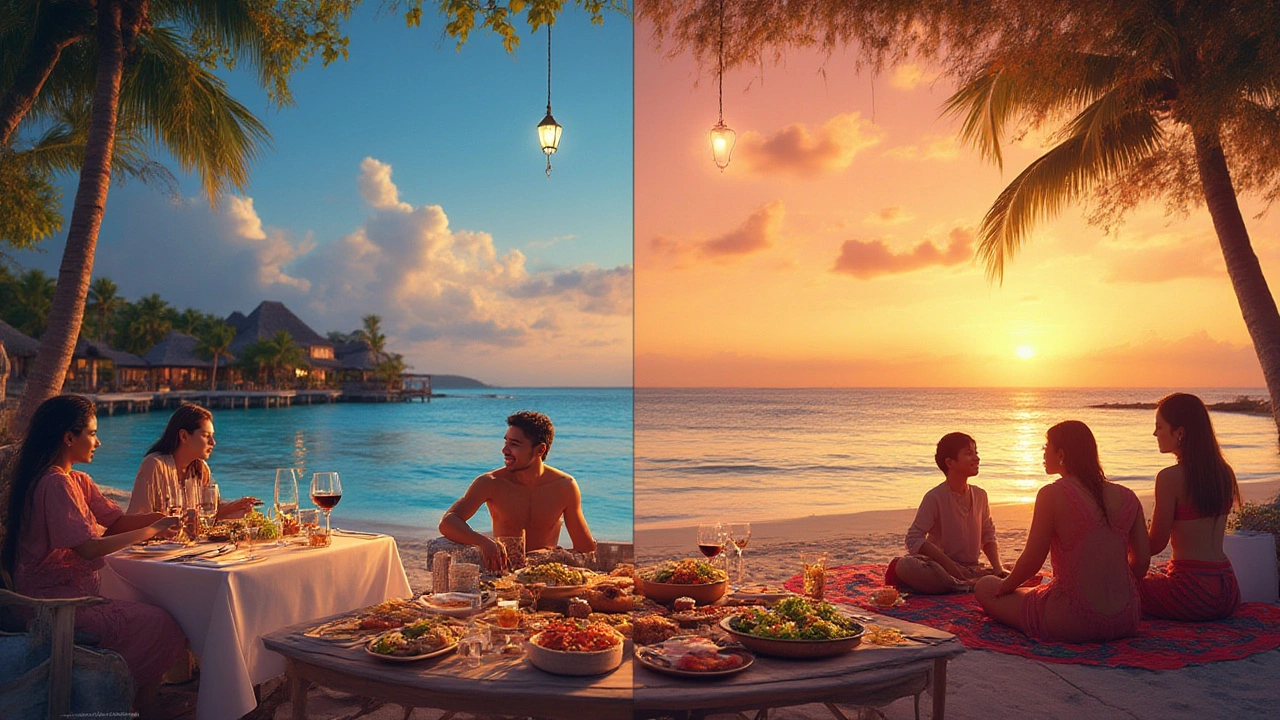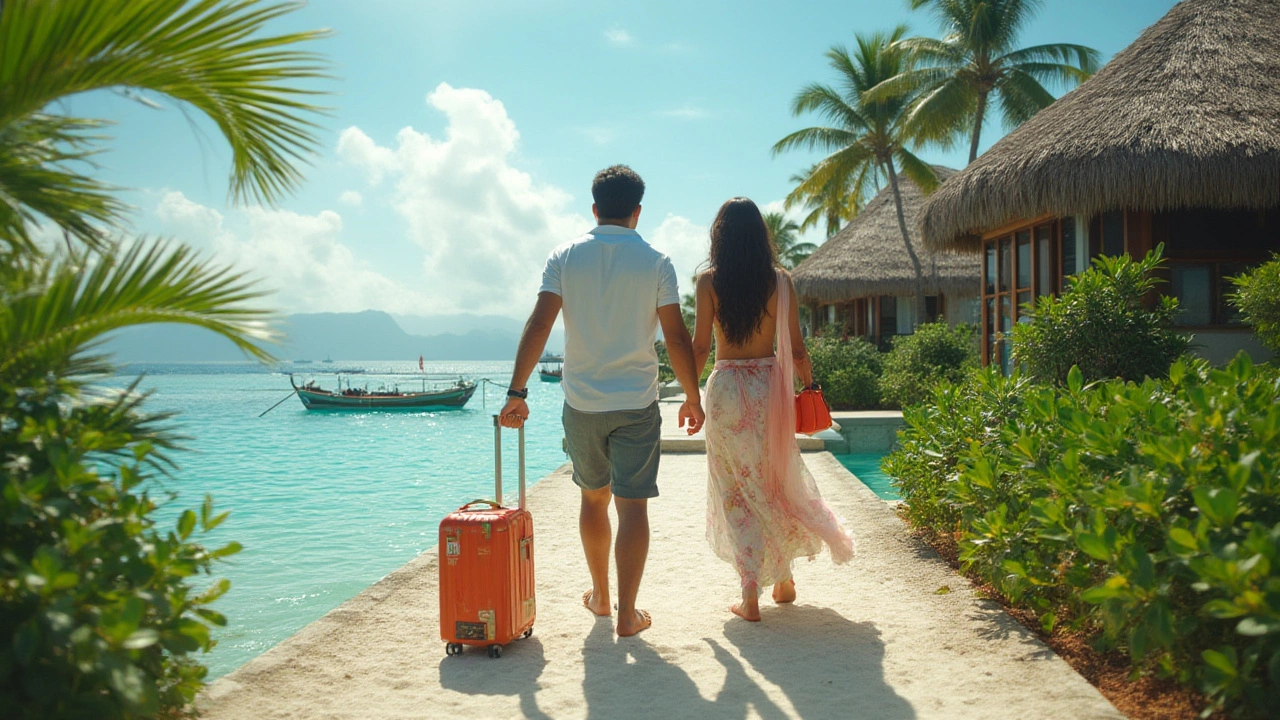Dreaming of a week in the Maldives? You’ve probably seen those drone shots of white-sand islands and neon-blue snorkeling water, but do you know what that fantasy really costs? The Maldives loves its luxury tag, but the numbers on your final bill can swing from eye-watering to surprisingly manageable—if you know where to look for savings. Let’s break the spell and show you what one week in paradise actually costs, from the wildest overwater bungalows to bare-bones guesthouses, all with zero sugar coating. Spoiler: you don’t have to be rich, but you do need to plan wisely.
How Much Does a Week in the Maldives Actually Cost?
The Maldives has 1,192 islands but only around 200 are lived on. Quick stat: about 150 of those islands are full-on resort escapes, and the remaining inhabited islands are home to cozy local guesthouses. The average visitor spends from $1,500 to more than $10,000 for a week, but that’s a big range—your numbers will depend on how you piece your trip together. Let’s slice it up line by line so you know what you’re really paying for.
Flights are probably the first big hurdle. Prices from India can be under $300 return, while trips from Europe or the US often start around $800–$1,500 for economy class. Peak season (December to April, especially Christmas and New Year) means higher fares, as everyone wants sunshine when it's winter elsewhere.
Once you get to Malé, the capital, you have the famous transfer fees—these can be jaw-dropping. It's not unusual for seaplane transfers to cost $300–$600 per person round trip to resorts on far-off atolls. Speedboat rides are cheaper if you stick to islands near Malé, usually ranging between $30 and $250 a person. Staying on a local island puts you on a public ferry, which costs $2–$10 one way, but schedules and comfort are, let’s just say, unpredictable.
Now, accommodation. The Maldives is split into two worlds—resort islands and local islands (where guesthouses have popped up fast since 2010). Top-end overwater villas? Be ready for $600–$2,500 per night in high season. These price tags include outlandishly spacious bungalows, glass floors, and the sort of bathtub views you see on Instagram. A good four-star resort room is closer to $300–$800 per night. If you want to go local, guesthouses cost as little as $40–$90 a night, with a private room, breakfast, and usually charming hosts. These local escapes are close to beaches, sometimes offer their own excursions, and let you sample real Maldivian life for a quarter of what you'd pay for a resort.
Resort life means nearly everything is marked up. Even a buffet dinner can set you back $50–$200 a head. Add a cocktail at $18, a bottle of water at $6, and you see how fast it climbs. Local islands are way more affordable: meals at a café may cost $5–$15, and groceries are also much cheaper than on resort islands.
Don’t forget the activities: Diving, snorkeling, fishing, dolphin tours—they’re not included unless you snag a high level "all-inclusive" package. Dives start around $50, whale shark excursions and island hopping will usually be $45–$120 per person. Simple snorkeling gear rental on local islands is $5–$10 a day, compared to free (or $30–$50 a day) at many resorts. Water sports? Banana boat rides, stand-up paddleboards, and jet skis run $30–$120 an hour depending on the activity and island.
Daily hidden charges can trip up new visitors: Taxes (12%), service charges (usually 10%), and the green tax ($6 per person, per night at resorts; $3 on local islands) are nearly always added on after the sticker price. For a family of four, that’s almost $170 for a week—worth knowing when you budget.
If you’re wondering about cost-cutting, consider this: Research from Booking.com in 2024 said the average stay on a local island ran about $600–$900 per person for the week, including midrange guesthouse lodging, several tours, and food. At a fancy resort, it’s around $3,000–$6,000 a head including flights, transfers, meals, and a couple of experiences. A split-stay (three nights guesthouse and four nights midrange resort) is a clever way to get both flavors, especially if you want those dreamy overwater villa photos for Insta, but don’t want to pay seven nights’ worth.
"The Maldives can be affordable and accessible to a wider market, but you need to manage your expectations, do your homework, and seek real value over status," says Lonely Planet travel writer Tamara Hinson.
Keep in mind, too: Family trips, solo adventures, and honeymoons all look different. Families usually grab larger villas and may skip romantic add-ons, while honeymooners tend to splurge for privacy, unique dining, and spa packages.
If you’re set on a budget trip, the Maldives Tourist Board actually maintains lists of government-approved guesthouses on its website. You’ll want to plan your route—some islands are hours apart, and only a handful have ATMs, so cash flow matters. Mobile data plans are affordable (locals use Ooredoo and Dhiraagu SIMs), and Wi-Fi is spotty outside big resorts.
It’s easy to forget that every drop of drinking water, every bite of cheese, and even basic building materials are shipped in. This explains why the islands can be pricier—even for simple pleasures like chocolate bars or imported fruit. Think of that when you eye the bill at your resort bar.

Types of Stays: Resorts vs Local Islands
Choosing between a resort island and a local island basically decides your whole Maldives experience. Both have their own magic and their own price tags, but the differences go way beyond just the final cost.
Let’s talk about Maldives resorts first. Picture lounging on a private deck, sea turtles gliding beneath a glass floor, infinity pools, and private chefs—the works. Resorts are all about ease and indulgence. Staff will whisk your bags, set up candlelit dinners on the sand, and pretty much take care of everything except your sunscreen. The catch? You’re usually stuck on the resort’s island for your whole stay. Unless you cough up for an expensive speedboat or seaplane transfer, you won’t be island-hopping. Many resorts charge big for extras like snorkeling trips or yoga classes. The rare “true” all-inclusive covers most or all meals, activities, minibars, nightly entertainment, and sometimes spa treatments, but double-check what’s actually included.
Usually, the least expensive resort rooms are garden bungalows or beach villas, a few minutes’ walk from the sea. Expect $350–$500 a night for low season, and double that or more at peak times. The overwater bungalows—those ones all your friends repost on TikTok—cost from $700 a night in summer, jumping to over $1,500 or even $3,000 at Christmas. Maldives resorts almost never include alcohol in the basic price (due to local laws), so if sundowners are your thing, expect a markup of $10–$22 per drink. Spa treatments? Great if you can afford them, running $80–$300 per session.
If you crave local flavor, the Maldives’ "guesthouse tourism" scene takes you to inhabited islands like Thulusdhoo or Maafushi, where you get to meet the real Maldives, eat spicy curries at beachfront cafes, and chat with fishermen after sunset. Guesthouses are not just budget-friendly—they give you access to public ferries and cheaper excursions. Activities like snorkeling, fishing, and island hopping run about one-fourth the cost of similar outings from a fancy resort. Many of these islands have their own “bikini beaches” (private strips for tourists, since most are Muslim islands where modesty is the rule), so you can still swim and tan without offending anyone.
The accommodation on local islands can be surprisingly chic—some spots offer rooftop views, boutique rooms, and splashy color schemes. Hoteliers are eager for five-star reviews and sometimes throw in perks like free excursions. Daily costs for meals, activities, and even coffee are much lower than the resort scene—the biggest spend here is probably your trip back to Malé airport.
You’ll want to plan ahead if you go local: ferries can be infrequent, some islands close down certain facilities during Ramadan, and the vibe is obviously much more laid-back than the polished resort world. But for travelers wanting value, adventure, and real insight, guesthouses win. You still get epic sunsets, crystalline seas, and all the snorkeling you can handle—but at a wallet-happy price.
If you’re torn, consider split stays: Start on a guesthouse island, then move to a swanky resort for your last couple of nights. Most resorts arrange pickups for private transfers, so you’ll breeze seamlessly from backpacker to baller with just one boat ride.
Quick tip about meals: Resorts control their own shops, so snacks and drinks are their way or no way—expect $5 for a bag of chips, $12–$18 for a drink. Local islands have corner shops and markets, so you can snack for a quarter of the cost. Free breakfasts are nearly always included at guesthouses, and some mid-range spots include dinner—which is rare at most three-star resorts.
Sustainability is a growing trend. Newer resorts and guesthouses use solar panels, desalinate their own water, and run conservation activities. Some resorts are 100% solar-powered now, and offer reef-safe sunscreen in the rooms, making them a smart pick for eco-conscious travelers. If you value “green” travel, these aren’t just buzzwords—they actually save on your bill (less energy use, less waste = more value).
So, what’s the bottom line? With a little flexibility, you can snag a fantastic week in the Maldives without spending a fortune. Guests who want all-out luxury pay for the privilege, but if you play your cards right, you’ll still get the sparkly beaches, snorkeling, and story-worthy sunsets on almost any budget.

Essential Tips to Stretch Your Budget in Paradise
Paying less for paradise isn’t just wishful thinking—it’s doable if you avoid classic tourist mistakes. First, time your trip smartly. The Maldives has two seasons: wet (May to November) and dry (December to April). Prices are lowest in the wet season, but it’s rarely nonstop rain—showers usually pass quickly, and you’ll have smaller crowds, more deals, and sometimes fewer mosquitos.
If you’re flying in, sign up for airfare deal alerts months before you plan to go. Use incognito mode when searching, as algorithms sometimes hike up prices if they sense you’re seriously interested. If you can be flexible on dates, Tuesdays and Thursdays are usually cheapest for long-haul flights.
Accommodation deals pop up last minute on booking sites in the shoulder months (May, June, October, November), so keep an eye out—some resorts quietly cut rates by 30% or more. Check if meals are included and if they offer a transfer discount (some will throw in airport pickups if you stay longer than four nights). Remember, "full-board" = all meals, "half-board" = breakfast and dinner, and "all-inclusive" may or may not cover drinks and certain activities, so always read the fine print.
Ditch those seaplane rides and pick a resort or guesthouse near Malé if you want to dodge those high-speed transfer bills. Maafushi, Thulusdhoo, and Gulhi are three of the most accessible—and best value—local islands. You can board a ferry for under $10 or grab a speedboat for $30–$40, making these islands a wallet-friendly option. Resorts like Kurumba or Velassaru are reachable by short and comparatively cheap speedboat rides.
Don’t dismiss package deals, especially if it’s your first time. Agencies sometimes snag discounts on bulk rooms or transfers and pass along the savings. If you’re comfortable booking direct, negotiate—especially in low season, as many local guesthouses will offer better rates for cash.
The Maldives is not a heavy tipping culture, but a small tip for staff (a couple dollars a day) goes a long way in terms of service and friendliness. For excursions, book locally—don’t pre-book from overseas unless you must, as local operators often beat resort prices by half.
Another tip: Bring strong reef-safe sunscreen, a reusable water bottle (many islands have refill stations now), snacks from home, and a dry bag for your gadgets. A waterproof phone pouch will get more use than you think. You’ll also save by packing your own snorkel mask and fins—rentals pile up if you plan to swim every day.
Make sure to have some cash in USD for things like transfers, staff tips, and small purchases—most guesthouses and even some resorts don’t accept cards. There are no ATMs on most resort islands, and only bigger local islands have banking.
Want a free adventure? Walk the beaches, snorkel from the shore, and chat with locals. Simple pleasures—like a sunset cowrie shell hunt or a $2 iced coffee at a beach café—are what actually make the Maldives memorable. If you visit a mosque or local village, dress modestly and cover shoulders and thighs out of respect for Muslim customs.
For couples or honeymooners wanting a once-in-a-lifetime dinner on the sand, ask guesthouse managers to organize it—they often know small, off-the-beaten-path spots for half the cost of a resort dinner. The Maldives government supports guesthouse tourism, so you’ll find strong English spoken, helpful tourism info, and easy-to-book tours on almost every local island.
The Maldives does have medical clinics, but travel insurance is a must in case you need to transfer off-island for emergencies. Don’t rely on resort pharmacies for anything serious—they tend to stock basics like sunscreen and Band-Aids, but little else. Bring your own meds or anything you can’t afford to run out of.
So, how expensive is the Maldives for a week? You can easily spend $10,000 if you want a top-end villa, private chef, sunset cruises, and spa treatments daily. But you can also skate by at $900–$1,500 per person if you play your cards right, mix up your stays, and spend sensibly. That’s the magic—and the challenge—of a Maldives vacation: it’s as expensive as you want it to be, but the sand, sea, and turquoise magic are free for everyone.
